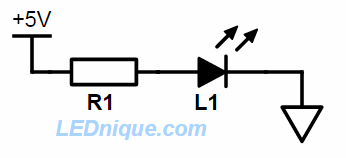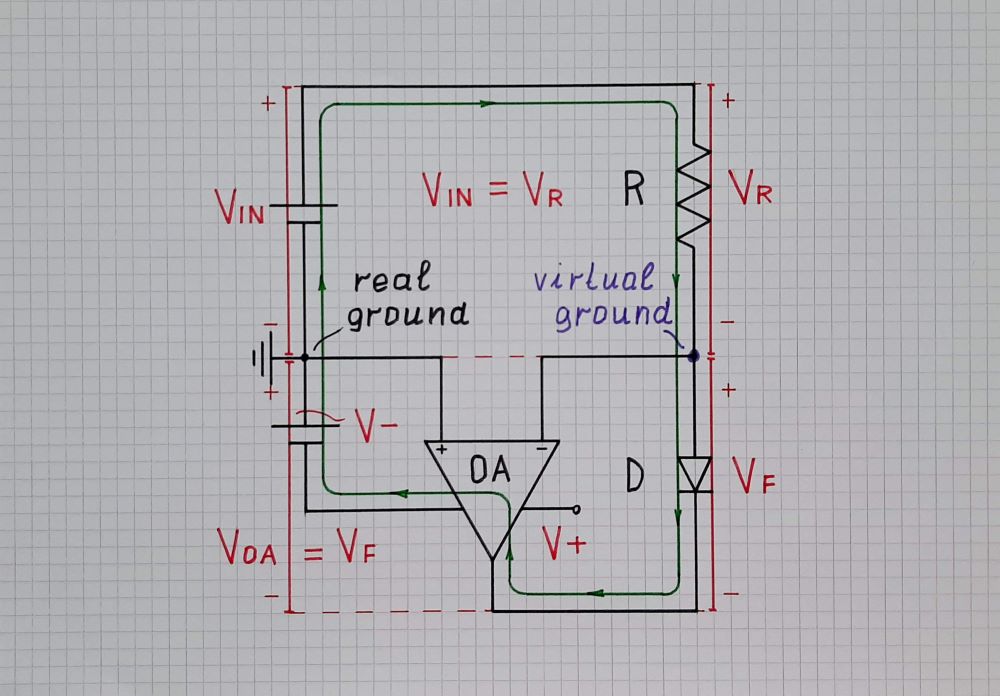Sample Schematic
So please find for your entertainment, analysis of the following circuit:

simulate this circuit – Schematic created using CircuitLab
(Most of the material that follows here can be readily found at this Wikipedia site: diode modeling. I will, however, take a different approach to their closed solution answer.)
Shockley Diode Equation
Assuming operation at its calibration temperature, the only relevant equation for the LED is the Shockley diode equation:
$$I_\text{D}=I_\text{SAT}\left(e^{\frac{V_\text{D}}{\eta\, V_T}}-1\right)$$
That equation is readily re-worked to solve for \$V_\text{D}\$:
$$V_\text{D}=\eta\, V_T\,\operatorname{ln}\left(\frac{I_\text{D}}{I_\text{SAT}}+1\right)$$
So, we have two different perspectives on the diode/LED.
For a diode-connected small-signal BJT, it is usually the case that the emission co-efficient (aka non-ideality factor) is \$\eta=1\$. But for many discrete diodes such as the 1N4148 or 1N4007, \$\eta>1\$. (It won't be less than 1.) Some LEDs will have rather high values (exceeding 4. not infrequently.)
The saturation current, \$I_\text{SAT}\$, is best seen as an extrapolated \$y\$-axis intercept. I talk about it here and also here and here.
\$V_T=\frac{k\, T}{q}\$ is the statistical thermal voltage and is a basic physics parameter with many important uses. At room temperature, it's often taken to be \$\approx 26\:\text{mV}\$.
Mathematical Closed Solution
The KVL equation for the above circuit is:
$$\begin{align*}
V_\text{CC} - R\,I_\text{D} - V_\text{D} &= 0\:\text{V}\\\\
V_\text{CC} - R\,I_\text{D} - \eta\;V_T \, \ln{\left(\frac{I_\text{D}}{I_\text{SAT}}\right)} &= 0\:\text{V}
\end{align*}$$
The problem here is in solving for \$I_\text{D}\$. You can easily solve this in an iterative fashion. Or, if you have a piece of paper with the diode equation plotted, you can use a ruler to add the resistor "load line" and find an approximate intercept. But for a closed mathematical solution without iteration, you need the product-log function (aka the LambertW function):
$$\begin{align*}
V_\text{CC} - R\,I_\text{D} - \eta\;V_T \, \ln{\left(\frac{I_\text{D}}{I_\text{SAT}}\right)} &= 0\:\text{V}\\\\
\frac{V_\text{CC}}{\eta\,V_T} - \frac{R\,I_\text{D}}{\eta\,V_T} &= \ln{\left(\frac{I_\text{D}}{I_\text{SAT}}\right)}\\\\
e^{^{\frac{V_\text{CC}}{\eta\,V_T}-\frac{R\,I_\text{D}}{\eta\;V_T}}} &= \frac{I_\text{D}}{I_\text{SAT}}\\\\
1 &= \frac{I_\text{D}}{I_\text{SAT}}\cdot e^{^{\frac{R\,I_\text{D}}{\eta\,V_T}-\frac{V_\text{CC}}{\eta\,V_T}}}\\\\
e^{^{\frac{V_\text{CC}}{\eta\,V_T}}} &= \frac{I_\text{D}}{I_\text{SAT}}\cdot e^{^{\frac{R\,I_\text{D}}{\eta\,V_T}}}\\\\
\frac{R\,I_\text{SAT}}{\eta\,V_T}\cdot e^{^{\frac{V_\text{CC}}{\eta\,V_T}}} &= \frac{R\,I_\text{D}}{\eta\,V_T}\cdot e^{^{\frac{R\,I_\text{D}}{\eta\,V_T}}}\\\\
&\text{set }u=\frac{R\,I_\text{D}}{\eta\,V_T}\\\\&\therefore\\\\
u\,e^u&=\frac{R\,I_\text{SAT}}{\eta\,V_T}\cdot e^{^{\frac{V_\text{CC}}{\eta\,V_T}}}\\\\
u&=\operatorname{LambertW}\left(\frac{R\,I_\text{SAT}}{\eta\,V_T}\cdot e^{^{\frac{V_\text{CC}}{\eta\,V_T}}}\right)\\\\
\frac{R\,I_\text{D}}{\eta\,V_T}&=\operatorname{LambertW}\left(\frac{R\,I_\text{SAT}}{\eta\,V_T}\cdot e^{^{\frac{V_\text{CC}}{\eta\,V_T}}}\right)\\\\
I_\text{D}&=\frac{\eta\,V_T}{R}\cdot\operatorname{LambertW}\left(\frac{R\,I_\text{SAT}}{\eta\,V_T}\cdot e^{^{\frac{V_\text{CC}}{\eta\,V_T}}}\right)
\end{align*}$$
(For those interested in more details about the product-log function, aka LambertW, please see Wolfram's LambertW site.)
Now, suppose \$V_\text{CC}=9\:\text{V}\$ and \$R=220\:\Omega\$. For the LED, let's use parameters taken from a Luminus PT-121-B LED: \$\eta=8.37\$, and \$I_\text{SAT}=435.2\:\text{nA}\$. (Assume \$V_T\approx 26\:\text{mV}\$, of course.) Then we'd find \$I_\text{D}\approx 29.9\:\text{mA}\$ and \$V_\text{D}\approx 2.42\:\text{V}\$. This is very close to the Spice simulation for the device and circumstances.
Or suppose we use the parameters for the 1N4148, \$\eta=1.752\$, and \$I_\text{SAT}=2.53\:\text{nA}\$, and use \$V_\text{CC}=5\:\text{V}\$ and \$R=1\:\text{k}\Omega\$. Then, for this common diode, we'd find \$I_\text{D}\approx 4.34\:\text{mA}\$ and \$V_\text{D}\approx 654\:\text{mV}\$.
As you can see, this works for all diode types. (The main limitation is the fact that \$I_\text{SAT}\$ varies widely over temperature -- discussed towards the end of the discussion on 'simplified diode models' where its variations due to one of the most important results from statistical mechanics, the Boltzmann factor, are further discussed.)
Summary
Closed solutions for basic diode questions are never basic. However, for most purposes it's usually enough to make a few simplifying assumptions and be "close enough for all intents and purposes." (To read about some of these, see 'simplified diode models' already mentioned a moment ago.) So you probably will never really need to do the above work. It's just nice to know what's involved, should you wonder about it. (Mostly, so you'll realize just why you use those simplifying assumptions, instead.)
Also take note that the closed solution is a large-scale solution and solves the question over a very, very large range of circumstances.
You were wondering about what happens when the applied voltage is equal to the diode voltage. But, in reality, the diode voltage adjusts itself to the circumstances. It's not fixed. So if you try to apply the so-called "diode voltage" to the circuit, the diode will instead adjust its voltage still lower so that the resistor's voltage drop will be "just enough" to provide the current that is "just enough" to yield the needed diode voltage to make up the difference. That's the real answer here. The above mathematical solution is just a complicated way of saying the same thing, but quantitatively instead of in a "hand-waving" way.
All of the above applies exactly the same as for any forward-biased diode of any kind. Even those with substantial (in the application) Ohmic lead resistance (which is then just added to the series resistance for analysis.)






